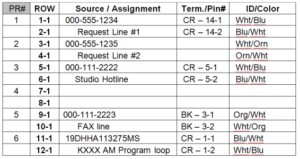Saving Money with a Phone Audit

[April 2014] Saving money is always popular with management. Yet, for many stations, a review of the phone bills often uncovers waste. Stephen Rutherford shows how to turn this sort of problem into an opportunity.
Shh! I am going to tell you a secret. It is a secret many seasoned engineers, like magicians, keep in their back pocket to protect the magic.
Using this secret, a lot of engineers have surprised their General Manager with a quick, easy way to make a substantial cut in station expenses – substantial enough to make many managers sit up and take notice. Even better, it makes the engineer a hero.
What is this “secret” you ask? It is auditing your company’s phone line services.
It really is a simple process in concept, but it does go beyond just looking at the monthly phone bill. True, it can be time consuming in application, which is why few stations do it, and why it usually works.
The Phone Line Audit
Phone line auditing is a project I always commence with a new client or employee after I have established a sound engineering maintenance routine.
The initial investment of time is used to determine where all the incoming phone lines are terminated; studios and at all transmitter sites. Over years of performing phone line auditing, I have developed a work sheet using Microsoft Excel that helps me document and extract the key information.
Insulation displacement punch blocks are the typical termination method employed by phone companies and my work sheets are laid out in such a way as to provide information for the position of each termination blade.
Because punch blocks come in so many different “flavors,” the work sheets are developed for the majority I have typically experienced.
The Worksheet
The worksheets should provide the following information for each termination blade (see the table on the next page):
The row and pins of the documented pair
Source and/or Assignment
Terminal or pin number of the other end
Circuit ID or Wire Color.
The chart shows the first dozen termination blades located in the upper left-hand section of the punch block. (If a punch block has four termination blades per row, then the next available blade in row #1 would have a ROW ID of 1-2, then 1-3 and 1-4 respectfully.)

A Good Place to Start
I always start with the incoming trunk circuits first, tracking back each pair to the Telco demark block, jotting down any circuit ID information and the individual wire colors.
If you are using a dial-up remote control device at your transmitter and/or studios, track the Telco line from the remote control back to your demark blocks and note their termination points on your worksheet. Do this as well if your station uses ISDN lines for remote broadcasts. All of these circuits, and any other dedicated program loops, are usually identified by a tag with the circuit number on it.
Furthermore, if your facilities have dedicated computer service lines, you should locate the service provider’s modem units and trace the lines to your demark block for identification.
Checking For Activity
Once the initial fact finding is completed, I start the next step either late at night or on a Saturday when the station personnel are not using the lines as much.
A telephone lineman’s butt set that is set for monitoring is very helpful to determine if there is any activity on each pair. When I find a “quiet” pair, I will switch the butt set on and, with a dial tone, I will call my cell phone to get the phone number for that circuit, jotting that number into the “Source / Assignment” cell for that circuit pair.
During this discovery process, you may hear what may sound like loud static. This usually is either a data circuit or a fax line. Note that on your work sheet for reference.
Documenting the Lines
After I have gone through all of the service demarks at each of my facilities, my next stop is at the business office.
With cooperation from the business office, it is now time to examine all of the telephone bills, correlating the billed phone numbers with the active phone numbers identified during my field research – as well as checking on the numbered circuits and program loops.
Sometimes the business office may not be very cooperative, citing confidentiality or other business issues. This is where the station manager needs to be working with you.
As we will see below, secrecy can cost a station big-time.
When a phone number is not on one of my work sheets, I make note of the number and the circuit ID information as well as the account number for the bill on a separate work sheet.
Identifying the Strange Numbers
First, I try calling these “unknown” phone numbers to see if they are answered, ring continuously, answered by an answering machine, or produce that automatic notification from the phone company system that the number is no longer in service.
After trying each number, I note the results on my “Unknown Numbers” worksheet.
At this point, it is time to contact line providers and ask for any further information about each of the discovered, but still unknown circuits. I ask if they have the address where the unknown line originates. With this information and a call to the Promotions Department it is often possible to determine quickly if they were remote broadcast lines.
Many times, I have found lines ordered for a remote broadcast that were never cancelled and the business had been using them at the broadcaster’s expense. Also, I have discovered ISDN circuits that were left un-cancelled for months (or years) because someone forgot to issue a cancellation request at the time the ISDN lines were ordered.

At the transmitter site, it is not uncommon to find old remote control, alarm, or program lines that are no longer in use.
But, do take care: the lines still may be needed for control or backup, and the cost is minimal (especially compared to being off air).
Expensive Long Distance Lines
The next phase of my phone line auditing project is to examine all the bills covering long distance. Unlike your cell phones, no, it is not all essentially “free.”
Sometimes there is only one long distance carrier but there could be more than one; the business office should help clarify this information as well. In small to medium sized markets, you may not have that many lines to inventory. For large markets this project can take several days to completely thrash out.
For example, in one market where I was the Chief Engineer, there were three studio buildings and five transmitter sites. The entire cluster had in excess of 250 lines provided by the phone company, and long distance was being provided by six different carriers. One long distance phone bill alone averaged $15,000 per month!
A smart and quick check is to verify how much the station is paying per minute for their long distance service. Take a typical call and divide the number of minutes into the cost for the call. Some big surprises can emerge from this check.
Watch Out for Odd Contracts
In the case of the $15,000 monthly long distance bill, what I found was that the station was paying $0.52 per minute.
Yep, over half a buck. As I started investigating this with the service provider, I learned the original contract was for $0.12 per minute. How did it grow to $0.52?
It turned out that one of the Sales Managers had up an account with that provider for an advertising package but did not bother to consult engineering about the line assignments.
Here was the “gotcha”: several of the business lines originally had been established for remote broadcasts – and, wait for it! – when those lines were cancelled at the end of their need, the long distance rate jumped to $0.52 per minute for all lines because a provision within the contract basically stated that any line cancellations within a specific time period would increase the long distance rate to become the tariff maximum!
Adding Up the Savings
When this project is completely finished, the result is a very clear knowledge of exactly what circuits are being paid for – and where they are being used.
From my work sheet, I compile all the data on the unused and “unknown” lines that need to be cancelled, including the monthly charges for each of the entries. There is also a request for management’s approval to cancel them.
This total savings information serves two very important needs. First, management will see very clearly the monthly savings to the operations budget. And secondly, you are demonstrating how your stewardship of the Engineering Department is saving expenses.
As you can see, this whole process is not quite as much a big secret as it is implementing intelligent policies and protocols aimed at operational efficiency.
Ongoing Documentation
To complete the task, the completed documentation sheets are put into plastic protector sheets within a “TELCO” binder for reference needs.
As lines are added or removed, this documentation can be quickly updated to reflect those changes. And, if you have more than one long distance provider, code each circuit entry with the long distance carrier.
The CE Should Be the Point Man
Normally, the Chief Engineer is the “Go To” person when a station needs to order a business line to a remote location, add additional lines for the station, or install an ISDN line for a sports event or remote broadcast.
On the other hand, I had clients that had authorized either the Program Director or Operations Manager to order phone lines for remote events. But, somehow, the Chief was left out of the loop because they felt it was not important enough to notify him. When the PD or OM is not “on top of” the task lines can remain on the bill because, well, “Out of sight, Out of mind” –and as much as $15,000 can be wasted each month.
Whenever I order temporary lines for remote broadcasts, I always insist on a “pull” or “drop dead” date for the order and ask for a order confirmation number, too. I keep a list of short service line numbers on my notice board to review when the service provider’s bill arrives.
If a short service line is being billed after the drop dead date, I immediately contact the provider with the line and confirmation number, asking full credit for the overbilling and that the line be removed from service. I have never had a problem with phone service providers rectifying those charges satisfactorily when approached this way. (After a couple of years, though, refunds may be rather limited.)
Lesson: Make sure the Chief Engineer is the Point Man for all phone activity. The benefits can be quite substantial, both monetarily and in your relationship with the station management.
– – –
Stephen Rutherford is a contract engineer based in Lincoln, NE. You can contact him at: twicethefirst@gmail.com
